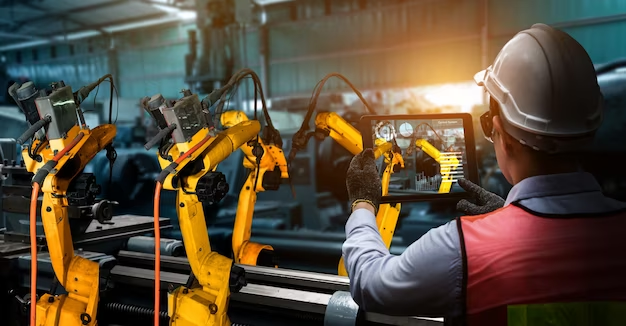The integration of industrial automation technologies has been revolutionizing the modern workplace, with significant implications for the future of work. In this blog, we will explore the impacts of industrial automation on the workforce and discuss the transformations that it brings. By understanding these effects, we can better prepare for the challenges and opportunities that lie ahead.
I. Impacts of Industrial Automation on the Workforce
Industrial automation has led to a transformation in the workforce, primarily through job displacement and transformation. Repetitive and routine tasks are increasingly being automated, resulting in changes in job roles and skill requirements. While this displacement may initially cause concern, it also brings economic implications, such as increased productivity and efficiency. Moreover, the automation revolution has the potential to create new job opportunities in emerging industries, leading to a more diversified workforce. However, it is essential to consider the social implications, such as income inequality and the impact on work-life balance and employee well-being.
Job displacement is a significant concern associated with industrial automation. As machines and algorithms take over repetitive and routine tasks, certain jobs may become obsolete. For example, assembly line workers in manufacturing industries are increasingly being replaced by robotic automation systems. However, it is important to note that while some jobs may be lost, new job roles emerge in areas such as machine maintenance, data analysis, and programming. This requires a shift in skill requirements, with a greater emphasis on technical and digital skills.
The economic implications of industrial automation are profound. By automating certain tasks, businesses can achieve higher productivity and efficiency levels, leading to increased output. This, in turn, can contribute to economic growth. Furthermore, the automation revolution can create new job opportunities in emerging industries. For instance, the development and maintenance of automation technologies require skilled professionals, stimulating job growth in those fields.
However, industrial automation also raises concerns about income inequality. While automation can enhance productivity and increase overall output, the distribution of wealth may become more skewed. Without appropriate measures in place, the benefits of automation may disproportionately favor business owners and high-skilled workers, exacerbating income inequality. Addressing this challenge requires proactive policies and initiatives to ensure equitable distribution of wealth and opportunities.
Additionally, the impact of automation on work-life balance and employee well-being needs careful consideration. Automation can potentially reduce work hours and alleviate the burden of repetitive tasks, allowing employees to focus on more meaningful and fulfilling work. However, it can also lead to increased expectations and pressure on workers to meet higher productivity standards. Striking a balance between automation-driven efficiency and maintaining healthy work environments is crucial for ensuring employee well-being and satisfaction.
II. Transformations in the Workplace due to Industrial Automation
The integration of industrial automation technologies not only replaces human labor but also transforms the nature of work itself. Collaboration between humans and machines becomes paramount as automation augments human capabilities and assists in decision-making processes. This collaboration creates a symbiotic relationship where humans bring contextual understanding, creativity, and empathy, while machines provide data-driven insights and perform repetitive tasks efficiently.
One significant transformation brought about by industrial automation is the rise of remote work and flexible arrangements. Automation technologies enable seamless communication and collaboration across geographically dispersed teams, facilitating remote work. This flexibility allows individuals to achieve a better work-life balance, eliminates geographical barriers for job opportunities, and enables organizations to tap into a global talent pool. However, it also poses challenges related to maintaining team cohesion and ensuring effective communication in virtual environments.
Automation also reshapes the nature of work by shifting the focus from repetitive tasks to higher-order cognitive activities. With routine tasks automated, employees have more time and energy to dedicate to creative problem-solving, innovation, and strategic thinking. This shift requires a workforce equipped with the necessary skills and mindset to thrive in an automation-driven workplace. Thus, there is a growing demand for individuals who possess critical thinking, complex problem-solving, and adaptability skills.
Upskilling and continuous learning initiatives become essential to prepare the workforce for these transformations. Organizations need to invest in reskilling programs to ensure employees can adapt to changing job requirements and leverage automation technologies effectively. Similarly, educational institutions must adapt their curricula to incorporate the necessary technical and digital skills, as well as foster lifelong learning habits. Collaboration between employers, educational institutions, and governments is crucial to establish comprehensive and accessible upskilling programs.
III. Challenges and Considerations for Industrial Automation
While industrial automation advances, several challenges and considerations arise that need to be carefully addressed. Ethical concerns regarding the impact on human dignity and job satisfaction must be at the forefront of discussions. As automation takes over certain tasks, individuals may experience a loss of purpose or fulfillment derived from their work. Therefore, it is essential to ensure that automation technologies are designed and implemented in a way that enhances job satisfaction and maintains human dignity.
Transparency and accountability in decision-making algorithms are vital to ensure trust and fairness. As automation systems make decisions that affect individuals' lives, it is crucial to understand the underlying processes and ensure that biases are minimized. Developing explainable and interpretable AI algorithms is essential for creating trust between humans and machines, enabling individuals to understand the reasoning behind automated decisions.
Workforce transition and reskilling become critical aspects of managing the impacts of automation. As jobs are displaced or transformed, strategies need to be developed to support displaced workers in their transition to new roles or industries. This may involve providing financial support, access to education and training, and assistance in identifying alternative career paths. Additionally, ensuring equal access to education and upskilling opportunities for all individuals is crucial to prevent exacerbating societal inequalities.
Regulatory and policy implications must also be considered in the context of industrial automation. Standards for safety and cybersecurity need to be established to ensure that automation technologies operate reliably and securely. Furthermore, proactive measures are required to anticipate and address potential job losses due to automation. Governments and policymakers play a crucial role in developing policies that foster innovation, support displaced workers, and promote inclusive economic growth.
IV. Opportunities and Recommendations
While industrial automation presents challenges, it also offers numerous opportunities. New job roles and industries emerge in the fields of automation and robotics, providing exciting prospects for career growth. For example, the demand for automation specialists, robotics engineers, and data scientists is expected to rise. By acquiring the necessary skills and knowledge in these areas, individuals can position themselves for success in the automation-driven job market.
Automation also fosters entrepreneurship and innovation. As businesses adopt automation technologies, new market opportunities arise. Entrepreneurs can leverage automation to develop innovative products and services, disrupt traditional industries, and create new business models. Governments and support organizations should provide resources and programs to encourage and nurture such entrepreneurial endeavors.
Collaboration between stakeholders, including industry, academia, and government, becomes essential to navigate the future of work successfully. Industry leaders should actively engage with educational institutions to shape curricula and provide real-world insights into the skills and competencies required in the automation era. Governments can facilitate partnerships and provide funding for research and development, as well as foster an enabling environment for innovation.
Lastly, the establishment of social support and safety nets is vital to mitigate the potential negative impacts of automation on society. Universal basic income and other social welfare programs can provide a safety net for individuals affected by automation-related job losses. Moreover, rethinking the concept of work and societal value is necessary. Automation can free individuals from repetitive tasks, enabling them to focus on creative and meaningful work that contributes to personal fulfillment and societal well-being.
In conclusion, Industrial automation is reshaping the future of work in profound ways. By understanding the impacts and transformations it brings, we can proactively prepare for the changing landscape. Embracing the potential benefits of automation while addressing the challenges requires collaborative efforts and forward-thinking policies. By doing so, we can navigate the future of work and create a society that maximizes the potential of industrial automation while ensuring the well-being and prosperity of all. As we move forward, let us seize the opportunities, mitigate the challenges, and shape a future where humans and machines collaborate harmoniously for a better world of work.








